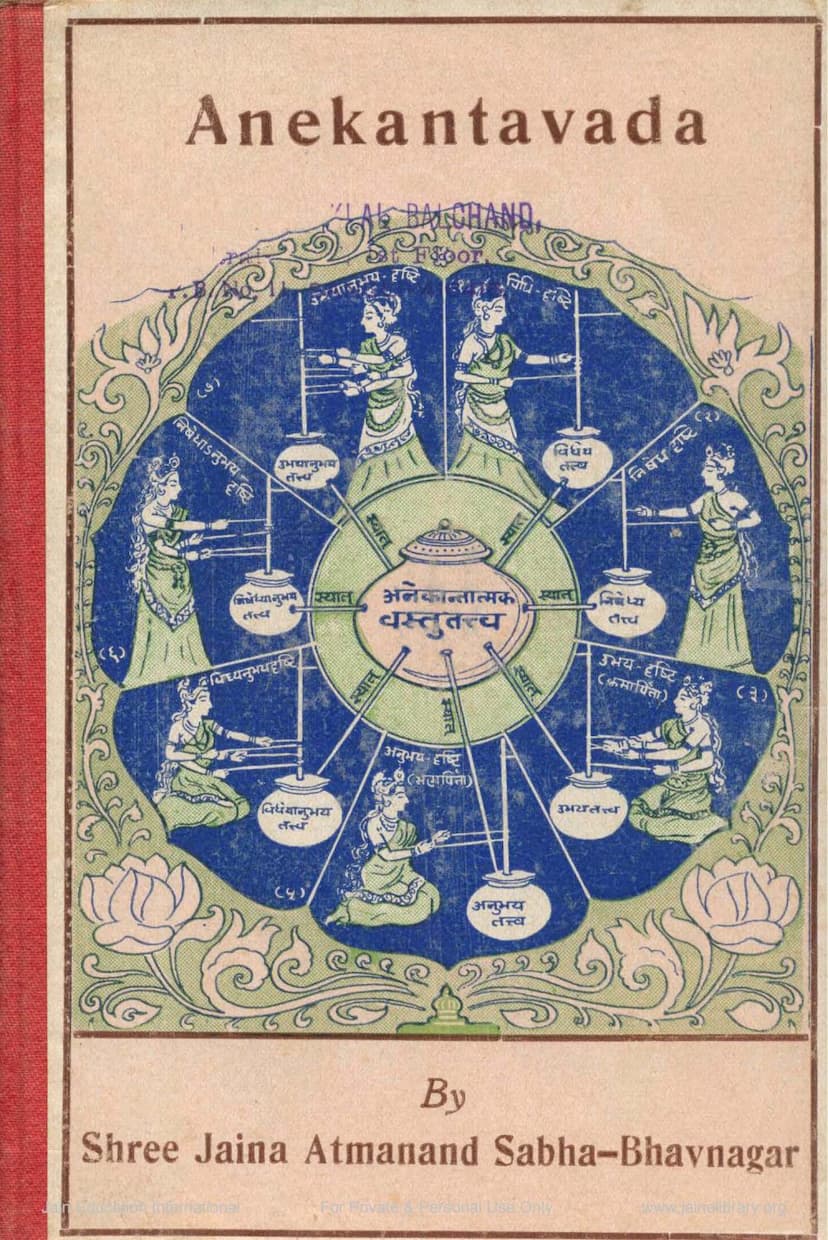Anekantavada
Added to library: September 1, 2025

Summary
Here is a comprehensive summary of the Jain text "Anekantavada" by Harisatya Bhattacharya, based on the provided pages:
Book Title: Anekantavada Author: Harisatya Bhattacharya Publisher: Shree Jaina Atmanand Sabha, Bhavnagar
Overall Theme:
"Anekantavada" by Harisatya Bhattacharya is a profound exposition of the Jain philosophical concept of Anekantavada, which translates to "manifold aspects" or "non-one-sidedness." The book argues that reality is inherently complex and multifaceted, and that true knowledge can only be achieved by understanding an object or phenomenon from multiple perspectives. The core of this multi-perspectival approach is the "Syad-vada" (the doctrine of possibility) and its systematic elaboration through the "Saptabhanga-naya" (the sevenfold predication).
Key Concepts and Arguments:
-
Anekantavada as the Foundation of Jain Epistemology: The book begins by establishing Anekantavada as central to Jain epistemology. It argues that metaphysics and epistemology are intertwined in Indian philosophy, and a correct theory of knowledge is crucial for understanding existence. Jain philosophy, unlike some monistic systems, embraces pluralism and the knowability of all substances.
-
Reconciling Opposing Views: Anekantavada is presented as a system that can reconcile seemingly contradictory philosophical viewpoints. By acknowledging that a proposition may be true from one perspective and false from another, it avoids absolute pronouncements and allows for a more comprehensive understanding of reality. This is crucial for achieving truth without falling into the pitfalls of one-sided or dogmatic thinking.
-
The Syad-vada and Saptabhanga-naya:
- Syad-vada: This doctrine, synonymous with Anekantavada and Sapeksha-vada, is explained as the principle of "possibility" or "in some respects." The use of the word "Syat" (meaning "perhaps," "may be," or "in some respects") at the beginning of a statement is a crucial reminder of the partial nature of any given assertion. It signifies that the statement holds true only under specific conditions and perspectives, and other perspectives may lead to different conclusions.
- Saptabhanga-naya: This is the systematic application of Syad-vada, outlining seven fundamental ways of predicating something about an object. Each of the seven "bhangas" (predications) represents a specific perspective or relationship between an attribute and an object, conditioned by factors like time, place, nature, and mood. The book meticulously details each of these seven predications:
- First Predication (Syadasti Eva): In some respects, it exists. This affirms existence under specific conditions.
- Second Predication (Syannasti Eva): In some respects, it does not exist. This negates existence under specific conditions, highlighting the complementary nature of negation to affirmation.
- Third Predication (Syadasti Eva Syannasti Eva): In some respects, it exists, and in some respects, it does not exist. This combines the affirmation and negation, presenting a more nuanced view.
- Fourth Predication (Syadavaktavya Eva): In some respects, it is inexpressible. This arises when seemingly contradictory aspects (like simultaneous existence and non-existence) cannot be adequately conveyed by language.
- Fifth Predication (Syadasti Eva Syadavaktavya Eva): In some respects, it exists, and in some respects, it is inexpressible. This combines affirmation with inexpressibility.
- Sixth Predication (Syannasti Eva Syadavaktavya Eva): In some respects, it does not exist, and in some respects, it is inexpressible. This combines negation with inexpressibility.
- Seventh Predication (Syadasti Eva Syannasti Eva Syadavaktavya Eva): In some respects, it exists, it does not exist, and it is inexpressible. This is the most comprehensive, combining affirmation, negation, and inexpressibility.
-
Critique of Ekantavada (One-Sidedness): The book actively critiques "Ekantavada," the doctrine of absolute or one-sided pronouncements, prevalent in other philosophical systems. It argues that Ekantavada leads to dogmatism, prejudice, and conflict by ignoring other valid perspectives. Jainism's approach, by contrast, fosters a spirit of tolerance and intellectual humility.
-
Realism and the Nature of Reality: Jainism is presented as a thoroughly realistic philosophy. It acknowledges the reality of both the subject (knower) and the object (known), as well as the interconnectedness of substance and its modes. The book refutes nihilistic and idealistic positions that deny the existence of external reality or the persistence of substance.
-
Practical Applications and Reconciliation of Philosophies: The book emphasizes that Anekantavada is not merely an abstract philosophical exercise but has profound practical implications. It is shown to be a tool for resolving disputes, fostering understanding, and achieving peace. The author uses examples from politics, social issues, and inter-religious dialogue to illustrate how Anekantavada can reconcile differing viewpoints. The text also engages with critiques from other Indian philosophical schools (like Vedanta and Sankhya) and demonstrates how Syad-vada can offer a more comprehensive and harmonious understanding.
-
The Importance of Nuance: A central argument is that truth is often found in the nuanced middle ground, avoiding extremes. The Saptabhanga framework provides a systematic way to approach this nuance, acknowledging that statements are not absolutely true or false but true "in some respects."
Structure of the Book:
The book is structured logically, moving from foundational concepts to detailed explanations of each of the seven predications. It includes:
- Foreword: By Prof. Jayantilal Bhaishankar Dave, emphasizing the significance of Jain epistemology and Anekantavada.
- Publisher's Note: Outlining the initiative to popularize Jain religion and culture through such publications.
- A Few Thoughts on Anekantavada: An introductory essay by the author.
- Introduction: Setting the stage for the complexity of Syad-vada.
- Chapters I-VIII: Detailed explanations of each of the seven predications, often with illustrative examples.
- Chapter IX: Counter-suggestions and criticisms considered and refuted.
- Chapter X: Conclusion, summarizing the importance and applicability of Anekantavada and Syad-vada for understanding reality and resolving conflicts.
- Prashasti (Benedictions): Philosophical verses in Prakrit and Sanskrit praising Anekantavada and the Jaina perspective.
- Index of Proper Names: A useful reference for the many philosophers and concepts mentioned.
Significance:
"Anekantavada" by Harisatya Bhattacharya is presented as a vital work for understanding the depth and comprehensiveness of Jain philosophy. It advocates for a non-dogmatic, multi-perspectival approach to knowledge and life, which the author believes is essential for achieving wisdom, harmony, and peace in a complex world. The book's rigorous exposition of the Saptabhanga-naya serves as a practical guide to applying the principles of Anekantavada.